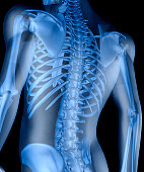Spinal fusion material, BMP, increases risk of benign tumors, not cancer

Using a certain bone grafting material for spinal fusion, one of the most common procedures for people with painful vertebral deteriorations, does not appear to result in higher rates of cancer, according to researchers at Duke Medicine.
However, the researchers found that the bone promoter known as recombinant human bone morphogenetic protein 2, or BMP, is associated with a higher rate of benign tumors in the brain and nervous system.
Reported in the September 2013, print edition of the journal Neurosurgery, the finding provides a better understanding of the long-term outcomes of spinal fusions using BMP. Recent studies have suggested that the growth factor is associated with harmful effects, including increased rates of cancer when used in high doses, leading to a decision by the U.S. Food and Drug Administration to reject approval of the higher dosage formulation.
Although BMP is approved only for use in the lower spine with anterior approaches for surgery, it has been widely used "off-label" in cervical fusions, posterior lumbar procedures, and minimally invasive approaches.
"Given the widespread use of BMP, there has been a tremendous need for better data about its effects," said lead author Nandan Lad, M.D., Ph.D., assistant professor in the division of neurosurgery at Duke University School of Medicine. "Our study is the largest to date examining the association between BMP use and cancer."
Using national claims data from commercial insurers, Medicaid and Medicare, Lad and colleagues conducted a large, retrospective analysis of more than 4,600 patients who had undergone spinal fusions with BMP and matched them against similar patients who had the procedure without the bone growth material. They examined the association between BMP and the general risk of cancer, as well as the risk of developing cancer in different tissues.
Overall, the Duke-led team found that 9.4 percent of spinal fusion patients receiving BMP developed malignant cancers, compared to 8.4 percent of patients not receiving the growth factor – a difference that was not statistically significant.
For benign tumors, there was a significantly higher risk. After adjusting to better match patients in both groups to eliminate selection bias, the researchers found that those who received BMP were 31 percent more likely to be diagnosed with benign tumors than those who did not receive the graft material. These tumors included non-malignant growths in the brain and nervous system.
"While the absolute risks were small overall, the increased risk for soft tissue tumors and those lining the nervous system among patients receiving BMP may be caused by the large local dose of BMP that is administered to the spine, and warrants further study," Lad said.
Lad said findings should be viewed with caution, noting that the limitations of the study include its retrospective design. However, the ethical and practical complications of prospectively enlisting patients in a head-to-head comparison of BMP against no growth factor made a large, retrospective study the next-best approach. Lad said the study also relies on accurate and timely diagnoses of cancer and benign tumors among the study population.
"We believe this study is the first to specifically investigate the association between the use of BMP and cancer risk in a systematic manner, and apply it to the general population of patients undergoing spinal fusion in the United States," Lad said.
















